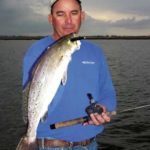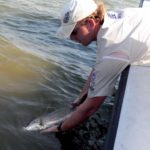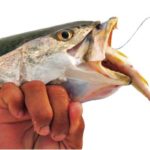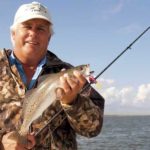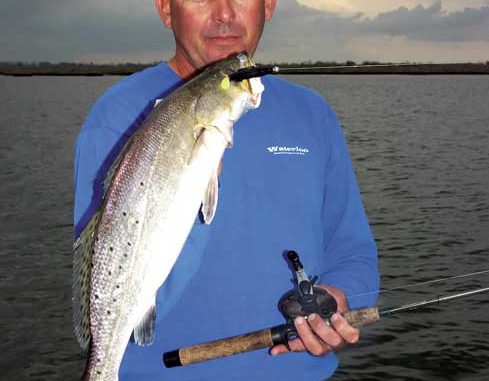
The preliminary data from the Calcasieu Lake speckled trout study is revealing some interesting findings.
Across the state of Louisiana, there is a lack of detailed scientific information about the movement of what ichthyologists would call the spotted sea trout, otherwise known to thousands of avid saltwater anglers as the speckled trout.
There are various theories about what speckled trout do at certain times of the year, but much of this information is based on angling observations and data collected by traditional tagging programs from the Coastal Conservation Association, most of which is difficult to figure out and winds up being a narrative of historical references rather than conclusive, scientifically collected data.
To help learn more about the movement of speckled trout, James Cowan, a professor in the LSU Department of Oceanography and Coastal Sciences, wrote a grant that funded a telemetry study, the process of gathering data about remote objects and transmitting the data electronically, intended to understand site fidelity and movement patterns of speckled trout in coastal Louisiana waters.
Working in cooperation with the Louisiana Department of Wildlife and Fisheries and along with the volunteer efforts of local anglers and the guides at Hackberry Rod & Gun, Cowan is combining the results of the telemetry study with the historical data from the CCA to focus on trout movement and exchange of trout between estuaries within the state.
“One of the primary estuaries we’re studying is Lake Calcasieu near Lake Charles,” said Cowan. “We’re very interested in what makes it a source of the trophy fish for which the lake is known. We’re curious about what is different about the trout in Calcasieu, and on a smaller scale Lake Pontchartrain. Are they biogenetically different than the fish in other bays? We’re not sure. It could depend on how much exchange there is between basins.”
The study at Lake Calcasieu is the project that LSU Oceanography and Coastal Sciences graduate student Jody Callihan chose for his Ph.D. dissertation research. Callihan is in charge of the telemetry study at Lake Calcasieu, and since the study’s inception in May 2007, he has tagged and released about 50 trout ranging from 12 inches to 29 inches with special acoustic transmitters that were inserted in a small incision below the stomach cavity of each fish.
Acoustic tags are much more effective than conventional tags because they emit an electronic ping sequence that is unique to each tagged fish. The ping sequences are “heard” by 50 receivers throughout the entire Calcasieu system any time a fish passes within 200 to 300 yards.
The unique signals go off every few minutes a staggered intervals, thus allowing Callihan to know which fish was recorded as well as the date and time of the detection. Some of the larger fish that were tagged received special transmitters that also identify the depth of the fish along with the water temperature.
According to Cowan, the detections allow them to map the patterns of movement from receiver to receiver.
“Of course, we don’t know if the fish was moving slowly or did 47 loops before it moved,” he said. “All it tells us is that the fish moved from one spot to the next.”
But that information is very valuable.
“With this system, we can semi-continually track individual trout movement patterns throughout the entire Lake Calcasieu system,” Callihan said.
The advantages of learning individual trout movement based on size, season and water conditions are obvious to anyone interested in catching speckled trout, the state’s most popular saltwater game fish. It was the popularity of the speckled trout combined with the serious lack of information about it that led Callihan to select it for his study.
“This work at Lake Calcasieu is funded by the Louisiana Department of Wildlife and Fisheries with Sport Fish Restoration dollars provided through the United States Fish and Wildlife federal assistance program,” Callihan explained. “It’s really a cooperative program, and we work closely together to meet the ultimate goal of better fish management.”
The big question at Lake Calcasieu is whether the fish move offshore and spend a lot of time out there. This study coupled with conventional tagging should help state agencies to make decisions where to draw lines as far as where the stock boundaries are, which would have an ultimate effect on determining if different management strategies are needed.
Callihan explained that stock boundaries are lines that divide different groups of fish that don’t mix with one another.
“For example, there may be some trout movement between Calcasieu and Vermilion Bay,” he said. “But they don’t go any farther than that. And maybe the fish from Barataria move to Terrebonne and vice versa, but they don’t move across the delta. The lines that they don’t cross are the stock boundaries.”
If through this study trout are found to move between systems, the obvious result would be that changing fishing regulations in one system, such as the 15-fish creel limit in Southwest Louisiana, would affect other systems as well.
System to system isn’t the only type of movement that Callihan is studying through his research. He’s also keeping up with seasonal migration patterns, how trout use different habitats and behavior ecology such as how movement differs with size and sex.
“If we can learn the movement patterns, it lets us gauge the vulnerability of fish to stressors like fishing pressure and industrial pollution,” Callihan said. “It will also help us determine if the artificial reefs are beneficial because we can compare them to natural oyster reefs in the system.”
While the ultimate goal of the study is to better the management of speckled trout, the most immediate question that all trout anglers are going to have is how will this study help them catch more fish? Knowing how trout move based on changes in temperature, salinity, tidal amplitude and direction and weather fronts would obviously benefit anglers.
Callihan is about a quarter of the way through the study, but he already has some preliminary results. He has learned some things that he expected he would discover, and he has learned some things that surprised him.
“We have some results in already,” Callihan said. “It’s important to note, though, that this is a 2-year study that started just a few months ago. The study will run through October 2009, so what we’ve learned up to this point is very preliminary. It’s going to take more time to solidify our data.”
One of Callihan’s first findings was that through late September 2007 about 40 percent of the tagged fish had a limited home range, and they tended to stay in one localized area like one pocket or one reef.
Beyond that 40 percent, about 16 percent were what he called transient in that they didn’t stay in one place very long, and they moved widely throughout the Calcasieu system in short time scales of one week or so.
Twenty percent of tagged fish showed a definite north to south shift over the summer. Callihan said fish were pushed down from Turner’s Bay, but it couldn’t be determined at this stage of the research if that north-to-south movement was based on anything more than the 20-plus inches of rain that the lake received during this time span.
“It’s no big surprise to learn that salinity has a big role in influencing trout movement,” he said. “And the final general pattern we have seen so far is that about 20 percent of the fish moved offshore during July and August and haven’t returned.”
Callihan added that the battery life of transmitters is about one year, and he can’t wait to see if these fish come back in the spring.
Many anglers may be wondering if these percentages can be farther broken down by size. In other words, was it the small fish that were homebodies and the large fish that were transient, or could it be the other way around?
“We haven’t really looked at that level of data yet, but there is a bit of anecdotal evidence that the schooling-size fish do roam more and are more transient than the bigger fish,” he said. “But one surprise we’ve seen so far is that there is a lot of diversity of movement from one trout to the next. We’ve had over 76,000 detections, which is a lot of data to go through, but right now the tendency is for the smaller males to be more exploratory and transient.”
While he hasn’t gotten into the fine-scale information at Lake Calcasieu, Callihan said expects to validate what most proficient anglers already know about trout movement as it relates to tide. Studies in the Barataria Basin have shown that fish respond to tide and will reposition on different sides of reefs based on the direction of the water movement.
He also expects to learn more about salinity and how much it varies and affects trout movement in a given day. In general, we already know that when salinity is high or depressed for long periods of time, an episodic event can have an almost immediate effect on trout movement from either a flood of fresh water or an intrusion of salt water.
“There really haven’t been any huge surprises yet,” Callihan added. “Lake Calcasieu is a small system, and I don’t think there are any real mysteries as to where the fish like to hang out. We have some specific data that only confirms what most already know, but we would like to keep that under wraps so our research results aren’t artificially affected. All our findings will be released after the study is completed.”
Since anglers will be the primary beneficiaries of this research, Callihan asked for all anglers to help out with the research when they catch a fish with a dark yellow tag sticking out below its dorsal fin. He requested that the angler please record the tag number and date of capture along with capture location and telephone number before carefully releasing the fish back into the system.
“There are such a small percentage of tagged fish that they are all valuable to the integrity of the study,” he explained. “The tags say LSU Reward Please Release, so you can’t miss them. Don’t cut the tag off. We ask that you please release the fish and call in the information that you recorded.”
Participating anglers will receive a tagging program T-shirt and cap, and they will be entered into a lottery for cash prizes up to $500 and merchandise like GPS navigation systems. Catching a big trout isn’t a reward, though, so don’t call in on the number to try to find out where the 9-pound trout is located because they aren’t going to tell you.
“For now, we can help anglers by explaining that the trout do seem to be associated with places where structure like reefs are present,” said Cowan. “And areas that have water movement through passes or between dredge islands along the ship channel tend to accumulate fish where current functions as a bait delivery method. We’ll tell you the truth, but we can’t reveal any strategic information.”
And Cowan explained that even though the study hasn’t shown any indication of a seasonal exit of trout out of the Calcasieu system at this point, it might just be a result of the warm fall Southwest Louisiana experienced last year.
“It’s hard to tell at this point if this is typical or it only happened because we didn’t have any cold weather,” he added. “We’ll just have to wait and see what happens next year. The one thing that’s important to remember is that if the fish that do leave the lake don’t return, it’s hard to argue that the Lake Calcasieu stock is somehow genetically isolated from others. Therefore, there must be something more to why that system has so many big trout.”
Just what that is will have to be determined. The key to a successful study is to keep the anglers interested in the project, which will run for another year and a half. If Callihan and Cowan can figure out where, when and why Louisiana’s most popular saltwater fish moves, that means you can be anchored there waiting on them when they do.
